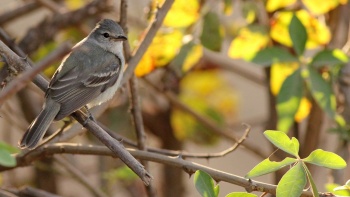- Camptostoma obsoletum
Identification
9·5–10·5 cm (3¾-4 in)
- Brown head
- Bushy crest
- Pale supercilium
- Olive-grey upperparts becoming paler on the rump
- Brown wings
- Yellow feather-edging
- Two white, yellow or cinnamon wing bars
- Brown tail
- Grey throat
- Yellow breast and abdomen
- Black bill (pale base to lower mandible)
Distribution
Central and South America:
Central America: found in Costa Rica, Panama, Trinidad
South America: Colombia, Venezuela, Guyana, Suriname, French Guiana, Ecuador, Peru, Bolivia, Brazil, Paraguay, Uruguay, Argentina
Taxonomy
Subspecies
This is a polytipic species consisting of 13 subspecies[1]:
Northern Group
- C. o. flaviventre: Pacific coast of south-western Costa Rica and Panama
- C. o. orphnum: Coiba and Cébaco islands (Panama)
- C. o. majus: Pearl Islands (Panama)
- C. o. caucae: Colombia (Western Andes, Cauca and Magdalena valleys)
- C. o. pusillum: Caribbean coast of northern Colombia and northern Venezuela; Trinidad
- C. o. napaeum: Extreme south-central Venezuela to the Guianas and northern Brazil
- C. o. olivaceum: South-eastern Colombia to eastern Ecuador, north-eastern Peru and western Brazil (western Amazonas)
Southern Group
- C. o. sclateri: Tropical western Ecuador and extreme north-western Peru (Tumbes and northern Piura)
- C. o. maranonicum: Northern Peru (middle Marañón Valley)
- C. o. griseum: Arid littoral of western Peru (Lambayeque to Lima)
- C. o. bolivianum: Central Bolivia to north-western Argentina (Tucumán)
- C. o. cinerascens: Eastern Brazil (Maranhão to Ceará and Mato Grosso) and western Bolivia
- C. o. obsoletum: South-eastern Brazil to Uruguay, Paraguay and northern Argentina
Habitat
A variety of scrubby habitats (including urban), tropical savanna, dry forest and stubble. Observed at heights between 400-600 m.
Behaviour
Diet
The diet consists of insects and spiders; also berries (particularly mistletoe) and small fruit.
Breeding
They build a domed nest, with a side entrance, from plant fibre or leaves. It is placed by a tree fork, often near a wasp nest. The clutch consists of 2 white eggs, marked with rufous and lilac. The female incubates the eggs for 14-15 days. The young fledge 17 days later.
Vocalisation
Recording by dominic.patagonia
Colon, Panama, January 2016
References
- Clements, J. F., T. S. Schulenberg, M. J. Iliff, D. Roberson, T. A. Fredericks, B. L. Sullivan, and C. L. Wood. 2016. The eBird/Clements checklist of birds of the world: v2016, with updates to August 2016. Downloaded from http://www.birds.cornell.edu/clementschecklist/download/
- Avibase
- Handbook of the Birds of the World Alive (retrieved February 2015)
- Wikipedia
- BF Member observations
Recommended Citation
- BirdForum Opus contributors. (2025) Southern Beardless Tyrannulet. In: BirdForum, the forum for wild birds and birding. Retrieved 18 May 2025 from https://www.birdforum.net/opus/Southern_Beardless_Tyrannulet





